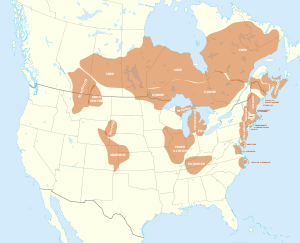
Back የአልጎንኲያን ቋንቋዎች ቤተሰብ Amharic اللغات الألغونكوية Arabic Llingües algonquines AST Alqonkin dilləri Azerbaijani آلقونکیان دیللری AZB Algonkin-Sprochn BAR Алганкінскія мовы Byelorussian Алгонкински езици Bulgarian Yezhoù algonkek Breton Llengües algonquines Catalan
| Algonquian | |
|---|---|
| Algonkian | |
| Geographic distribution: | North America |
| Linguistic classification: | Algic
|
| Proto-language: | Proto-Algonquian |
| Subdivisions: | |
| ISO 639-2 and 639-5: | alg |
 Pre-contact distribution of Algonquian languages | |

The Algonquian /ælˈɡɒŋkiən/ or /ælˈɡɒŋkwiən/;[1] (also Algonquin, Algonkian) languages are a subfamily of Native American languages that includes most of the languages in the Algic language family.[2] The term "Algonquin" comes from the Maliseet word elakómkwik (pronounced [ɛlæˈɡomoɡwik]), "they are our relatives/allies".[3][4] Many Algonquian languages are extremely endangered today, while a number of others have already died out completely. There are about 30 languages. The three categories of the Algonquian languages are Plains Algonquian Languages, Central Algonquian Languages and Eastern Algonquian Languages.
Speakers of Algonquian languages stretch from the east coast of North America all the way to the Rocky Mountains. The language from which all of the languages of the family come was spoken at least 3,000 years ago.
The Algonquian languages are 'poly-synthetic', which means that you can make entire sentences in one word.
- ↑ "Algonquian". Dictionary.com. Retrieved 2008-07-07.
- ↑ The two Algic languages that are not Algonquian are Wiyot and Yurok of northwestern California) That language family was named for the Algonquin language, from which it should be carefully distinguished.
- ↑ Campbell (1997:401 n. 133, 136)
- ↑ Bright, William (2004). Native American Place Names of the United States. Norman: University of Oklahoma Press, pg. 32